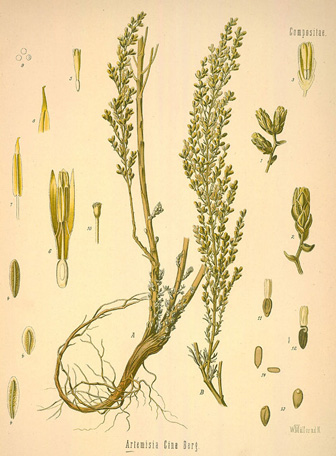EpazoteChenopodium ambrosioides
From An Herbalist in the Kitchen

Köhler, F. E. Köhler's Medizinal-Pflanzen in naturgetreuen Abbildungen mit kurz erläuterndem Texte: Atlas zur Pharmacopoea germanica.
Volume 1 of 3. Gera-Untermhaus: F.E. Köhler, [1883-1914].
Courtesy of the Rare Book Collection of the Missouri Botanical Gardens.
Other Common or Ethnic Names
- American Wormseed, Epazolte, Hedge Mustard, Hierba Sancti Mariae, Jerusalem Oak, Jerusalem Parsley, Jesuit's Tea, Mexican Tea, Sweet Pigweed, West Indian Goosefoot, Wormseed
- Epazote has been known, scientifically, as Chenopodium anthelminticum, Artemisia cina and Teloxys ambrosiodes. Its old pharmaceutical name was Herba Chenopodii Ambrosioides.
- Columbia: Cenizo
- Estonia: Urt-hanemalts
- Finland: Saitruunasavikka
- Germany: Jesuitentee, Karthausertee, Mexicanisches Teekraut, Mexicanischer Traubentee, Wohlriechender Gansefuss
- India: Kadavoma, Katuayamodakam
- Italy: Allemand
- Mexico: Ambrosia, Apazote, Epazote de Comer, Ipazote, Lipasote, Pasote, Pazote, Teloxya, Yerba de Santa Maria
- Netherlands: Amerikaans Wormzaad, Welriekende Ganzenvoet, Wormkruid, Wormzaad
- Norway: Sitronmelde
- Panama: Paico
- Poland: Komosa Pizmowa
- Portugal: Mastruz
- Russia: Mar
- Spain: Yerba de Santa Maria
- Sweden: Citronmalla
Related Species
- Atriplex hortensis: Arroche, Crimson Plume, Garden Orach, Mountain Spinach, Orache, Red Orach. Use as a garnish. Cultivars include: 'Atrosanguinea,' 'Cupreatorosea,' 'Rosea 'and 'Rubra' (may be the same species as Atriplex angostipolia).
- Basella rubra: Ceylon Spinach, Malabar Nightshade, Vine Spinach
- Chenopodium album: Quenopode (Spain); Seviche (Italy); Vlita (Greece); Chenopodio, Farinello Bianco (Italy); Quelite Cenizo, Quelites (Mexico); Vromochorto (Greece); Bledes, Fat Hen, Lamb's Quarters, Pigweed, White Goosefoot, Wild Beets, Wild Spinach
- Chenopodium berlandieri: Hojas de Huazontle, Huazontle, Huauzontle, Quelite Cenizo, Quelites (Mexico); Lamb's Quarters
Chenopodium bonus-henricus: Fette Henne (Germany); Allgood, English Mercury, Good King Henry, Mercury, Allgood, Fat Hen, Goosefoot, Mercury Goosefoot, Smearwort, Tola Bona, Wild Spinach - Chenopodium botrys: Ambrosia
- Chenopodium graveolens: Epazote de Zorillo, Wormseed (also listed as Chenopodium foetidum)
- Chenopodium murale: Australian Spinach
- Chenopodium nuttaliae: Huazontle (Mexico); Lamb's Quarters
- Chenopodium Quinoa: Quinua (Columbia); Petty Rice, Quinoa -- is the source of the Andean grain (small, round, brownish starch with a pleasant, slightly bitter, nutty flavor).
- Salicornia europea: Almyrides (Greece); Salicorn (Spain); Salicornia (Italy); Chicken Claws, Glasswort, Marsh Samphire, Pigeon Foot
- Suaeda torreyana: Romerito (Mexico)
Growth Habits
Annual
Origin: Tropical Americas
Range: Cosmopolitan weed
Culinary Uses
Epazote is used in southwestern United States and Mexico, dried and fresh, especially with beans. In Mexican markets, three forms are recognized: el blanco, el epazote verde and el morado. El morado, the most aromatic, is preferred.
Freshwater snails, called Jutes, are seasoned with Epazote in Central America.
Flower spikes can be steamed. Epazote was used as a tea, in Germany, in the eighteenth century.
Lamb's Quarters and Good King Henry are eaten as cooked greens, used as stuffings, tossed in salads, and sometimes added to soups.
Glasswort, Salicornia europea, has been used like Samphire, Crithmum maritimum. It has a crunchy, salty taste that makes it useful as snacks or in salads. The French lump them together with Salsola kali as "Les Salicornes."
During Lent, in Mexico, the Rosemary-like leaves of Suaeda torreyana are combined with dried chiles, to flavor the broth for dumplings made of egg and dried Shrimp: Tortas de Camaron. The tender shoots of Chenopodium berlandieri are sautéed with garlic and onions in Mexico, or deep-fried.
Epazote has a flavor that has, uncharitably, been likened to that of kerosene. That flavor, no matter how described, results from the combination of a-Pinene, d-Camphor, Cineole, p-Cymene, l-Limonene and Myrcene.
Other Uses
Epazote is said to reduce the gas-producing qualities of beans. This flatulence is the result of fermentation of complex (indigestible) sugars in the large intestine. It has been suggested that essential oils in a number of herbs and spices alter the chemical environment of the lower intestine, thereby inhibiting the fermentation of those polysaccharides. This hypothesis remains to be proved. However, science has developed two strategies to conquer the problem of inflation.
First, genetically redesign the bean, to eliminate the complex sugars. That's the complicated method.
A simpler technique is to precede the consumption of bean dishes with appropriate enzymes to break down the complex sugars in the upper part of the digestive system. It's the same approach used by lactose-intolerant people when they want to drink milk or eat cheese.
Virtually every culture that consumes large amounts of vegetables, especially gassy ones like beans or members of the cabbage family, has offered folk remedies for the age-old problem. They range from varying cooking techniques (such as cooking in several changes of water -- which serves only to reduce the quantity of water-soluble vitamins and minerals), to additions of herbs and spices (it is interesting to note that the seasonings chosen are invariably the culture's favorites, anyway), to more arcane and mystical rituals. These solutions reveal an utterly charming optimism and trust in unverified anecdotal evidence. Until modern science masters this mephitic monster, it is best to follow the advice of Benjamin Franklin: "Fart Proudly."
Epazote is sometimes cultivated as a source of a medicinal oil, but most culinary Epazote is harvested from wild plants (weeds). It looks like Lamb's Quarters, but the edges of the leaves are toothed, not wavy.
Comments
Epazote is a weed almost everywhere, although seeds are available from Shepherd's Garden Seeds, in Torrington, CT.
Caldo de Huevo para la Goma is a Guatemalan soup that is said to be an effective cure for a hangover. In addition to fresh Epazote, it contains Chiles, Scallions, Tomatoes and poached Eggs -- not a thing I would care to experience first thing on the morning after. On the other hand, a good Bloody Mary has some of these ingredients, and they have been prescribed for this self-inflicted malady, so who knows?
According to one source, Epazote is poisonous if consumed to excess. What defines "excess" is unclear. It has been used constantly in "Tex-Mex" cooking without reports of poisoning, so use your own judgment.
"Jesuit's Tea" is also used as a name for Mate, Ilex paraguariensis, and Psoralea glandulosa.
"Quelite" is also used as a name for Amaranthus cruentes -- and many other greens.
Marsh Samphire is not related to Samphire.
